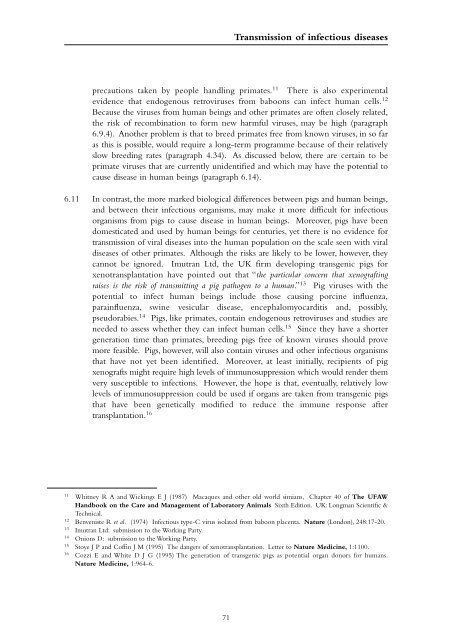Xenotransplantation - Nuffield Council on Bioethics
Xenotransplantation - Nuffield Council on Bioethics
Xenotransplantation - Nuffield Council on Bioethics
Create successful ePaper yourself
Turn your PDF publications into a flip-book with our unique Google optimized e-Paper software.
Transmissi<strong>on</strong> of infectious diseases<br />
precauti<strong>on</strong>s taken by people handling primates. 11 There is also experimental<br />
evidence that endogenous retroviruses from babo<strong>on</strong>s can infect human cells. 12<br />
Because the viruses from human beings and other primates are often closely related,<br />
the risk of recombinati<strong>on</strong> to form new harmful viruses, may be high (paragraph<br />
6.9.4). Another problem is that to breed primates free from known viruses, in so far<br />
as this is possible, would require a l<strong>on</strong>g-term programme because of their relatively<br />
slow breeding rates (paragraph 4.34). As discussed below, there are certain to be<br />
primate viruses that are currently unidentified and which may have the potential to<br />
cause disease in human beings (paragraph 6.14).<br />
6.11 In c<strong>on</strong>trast, the more marked biological differences between pigs and human beings,<br />
and between their infectious organisms, may make it more difficult for infectious<br />
organisms from pigs to cause disease in human beings. Moreover, pigs have been<br />
domesticated and used by human beings for centuries, yet there is no evidence for<br />
transmissi<strong>on</strong> of viral diseases into the human populati<strong>on</strong> <strong>on</strong> the scale seen with viral<br />
diseases of other primates. Although the risks are likely to be lower, however, they<br />
cannot be ignored. Imutran Ltd, the UK firm developing transgenic pigs for<br />
xenotransplantati<strong>on</strong> have pointed out that “the particular c<strong>on</strong>cern that xenografting<br />
raises is the risk of transmitting a pig pathogen to a human.” 13 Pig viruses with the<br />
potential to infect human beings include those causing porcine influenza,<br />
parainfluenza, swine vesicular disease, encephalomyocarditis and, possibly,<br />
pseudorabies. 14 Pigs, like primates, c<strong>on</strong>tain endogenous retroviruses and studies are<br />
needed to assess whether they can infect human cells. 15 Since they have a shorter<br />
generati<strong>on</strong> time than primates, breeding pigs free of known viruses should prove<br />
more feasible. Pigs, however, will also c<strong>on</strong>tain viruses and other infectious organisms<br />
that have not yet been identified. Moreover, at least initially, recipients of pig<br />
xenografts might require high levels of immunosuppressi<strong>on</strong> which would render them<br />
very susceptible to infecti<strong>on</strong>s. However, the hope is that, eventually, relatively low<br />
levels of immunosuppressi<strong>on</strong> could be used if organs are taken from transgenic pigs<br />
that have been genetically modified to reduce the immune resp<strong>on</strong>se after<br />
transplantati<strong>on</strong>. 16<br />
11<br />
Whitney R A and Wickings E J (1987) Macaques and other old world simians, Chapter 40 of The UFAW<br />
Handbook <strong>on</strong> the Care and Management of Laboratory Animals Sixth Editi<strong>on</strong>. UK: L<strong>on</strong>gman Scientific &<br />
Technical.<br />
12<br />
Benveniste R et al. (1974) Infectious type-C virus isolated from babo<strong>on</strong> placenta. Nature (L<strong>on</strong>d<strong>on</strong>), 248:17-20.<br />
13<br />
Imutran Ltd: submissi<strong>on</strong> to the Working Party.<br />
14<br />
Oni<strong>on</strong>s D: submissi<strong>on</strong> to the Working Party.<br />
15<br />
Stoye J P and Coffin J M (1995) The dangers of xenotransplantati<strong>on</strong>. Letter to Nature Medicine, 1:1100.<br />
16<br />
Cozzi E and White D J G (1995) The generati<strong>on</strong> of transgenic pigs as potential organ d<strong>on</strong>ors for humans.<br />
Nature Medicine, 1:964-6.<br />
71
















